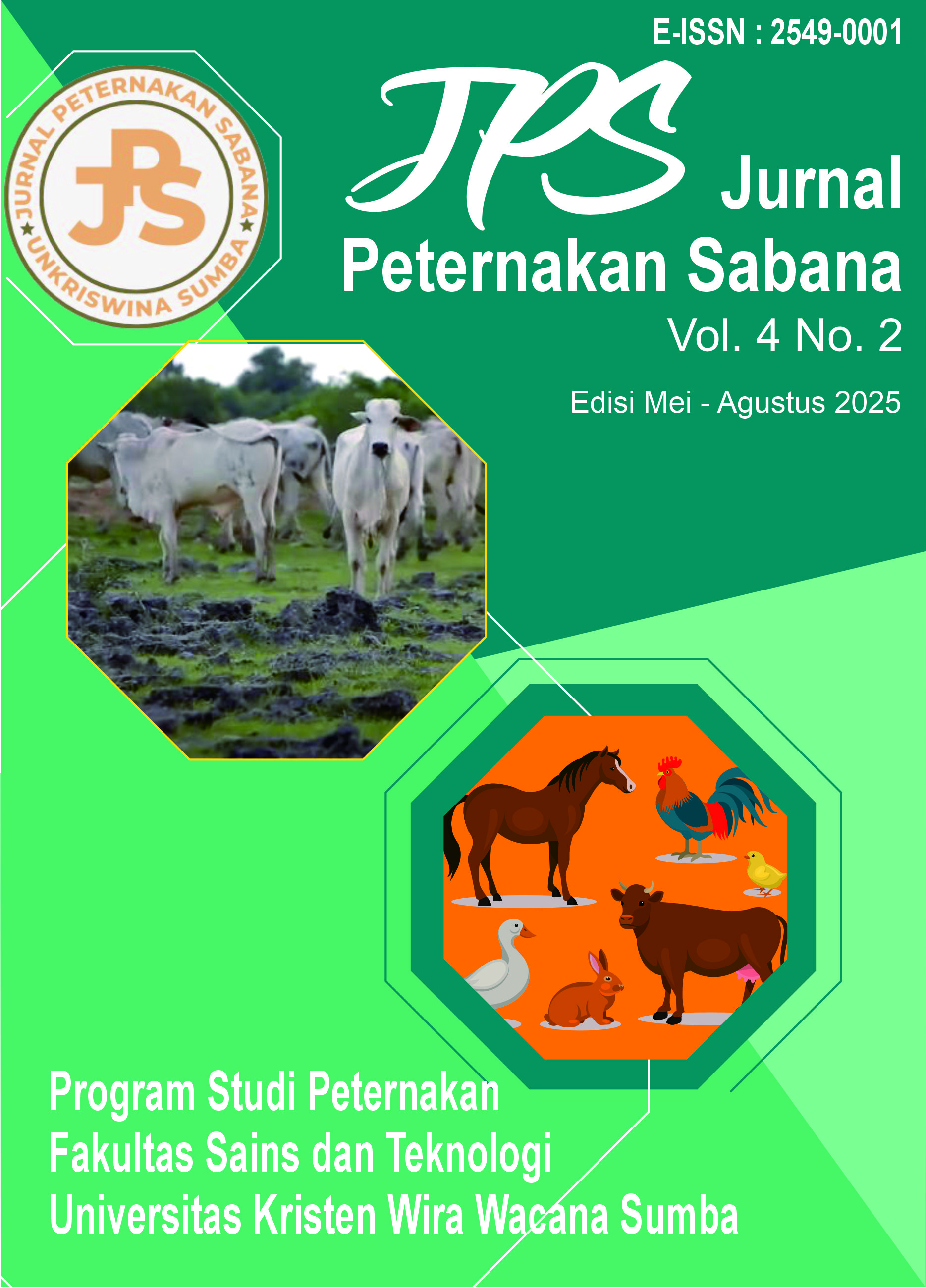Pemanfaatan Ekstrak Kandangu Mbuku Pada Konsentrasi yang Berbeda dan Pengaruh Terhadap Mutu Organoleptik Dan Kimiawi Kerupuk Telur Asin
DOI:
https://doi.org/10.58300/jps.v4i2.1436Keywords:
ekstrak kandangu mbuku, kerupuk telur asin, organoleptik, kimiawi, pH, kadar airAbstract
This research aims to determine the effect of using local basil extract (bladder mbuku) at different concentrations and the effect on the organoleptic and chemical quality of salted egg crackers. This research was carried out at the Integrated Laboratory of Wira Wacana Christian University, Sumba. The eggs used in this research were 30 RAS chicken eggs. This research used a Completely Randomized Design (CRD) consisting of 4 treatments with 5 replications, namely P1= addition of 30% basil leaf extract, P2= addition of 35% basil extract, P3= addition of 40% basil extract, and P4= addition of 45% basil extract so there were 20 sample units. The observation variables are oroleptic (color, taste, texture, aroma), chemistry, pH, water content. The data obtained was analyzed by ANOVA with a confidence level of 5%, and if there was a real effect, it was followed by the Ducan test. Meanwhile, organoleptic data was processed using the Kruskas Wallis method. The results of the research using the addition of different extracts did not significantly differ in terms of pH and water content, whereas for the organoleptic test, the administration of extract with the addition of 45% basil gave a real effect and gave the taste of salted egg crackers and the test for tannin levels as a natural preservative in crackers was in standard conditions according to SNI
Downloads
References
Anindita, N. S., & Soyi, D. S. (2017). Studi kasus: pengawasan kualitas pangan hewani melalui pengujian kualitas susu sapi yang beredar di kota Yogyakarta. Jurnal Peternakan Indonesia (Indonesian Journal of Animal Science), 19(2), 96-105.
Patria, C. A., Nurhayati, N., & Rumiyani, T. (2023). Basil Leaf (Ocimum sanctum L.) Extract Activities in Dringking Water as A Phytobiotics on The Productivity of Jowo Super chicken. Jurnal Agribisnis Peternakan (JINAK), 1(1), 27-32.
Angelina, M., Turnip, M., & Khotimah, S. (2015). Uji aktivitas antibakteri ekstrak etanol daun kemangi (Ocimum sanctum L.) terhadap pertumbuhan bakteri Escherichia coli dan Staphylococcus aureus. Jurnal Protobiont, 4(1), 184-189.
Bawinto, A. S., Mongi, E., & Kaseger, B. (2015). The analysis of moisture, pH, sensory, and mold value of smoked tuna (Thunnus sp.) at Girian Bawah District, Bitung City
Bustanul, A., & Sanusi, I. (2018). Struktur, Bioaktivitas Dan Antioksidan Flavonoid. Jurnal zarah, 6(1), 21-29.
Lukito, G. A., Suwarastuti, A., & Hintono, A. (2012). Pengaruh berbagai metode pengasinan terhadap kadar NaCl, kekenyalan dan tingkat kesukaan konsumen pada telur puyuh asin. Animal Agriculture Journal, 1(1), 829-838.
Naufalin, R., & Yanto, T. (2012). Pengaruh Konsentrasi Ca (Oh) 2, Jenis Bahan Pengawet Alami dan Lama Simpan Terhadap Kualitas Nira Kelapa. Pembangunan Pedesaan, 12(2).
Hendrikayanti, R. H., Fahmi, A. S., & Kurniasih, R. A. (2022). Optimasi waktu pengukusan dan suhu penggorengan kerupuk ikan patin menggunakan response surface methodology. JFMR (Journal of Fisheries and Marine Research), 6(1), 78-90.
Imansari, F., Djaelani, M. A., & Tana, S. (2018). Kualitas Telur Ayam Ras Setelah Pencelupan Ke Dalam Larutan Rumput Laut Berdasarkan Waktu Penyimpanan. Jurnal Akademika Biologi, 7(3), 8-12.
Wiranata, M. A., Sanyoto, J. I., & Subagja, H. (2017). Analisis profitabilitas usaha peternakan ayam kampung super di Kabupaten Jember. Jurnal Ilmu Peternakan Terapan, 1(1), 31-38.
Zurah, C.F. 2006. Karya Ilmiah Flavor (citarasa). Dapertemen Kimia. Universitas Sumatra Utara. Hal 1-27kastam
Downloads
Published
Issue
Section
License
Copyright (c) 2025 JURNAL PETERNAKAN SABANA

This work is licensed under a Creative Commons Attribution-ShareAlike 4.0 International License.
The author who submits the manuscript must understand and agree that the copyrights published are held by Jurnal Peternakan Sabana. Copyright includes rights to reproduce, distribute and sell every part of journal articles in all forms and media.
All articles published Open Access will be immediately and permanently free for everyone to read and download. We are continuously working with our author communities to select the best choice of license options, currently being defined for this journal as follows:
• Creative Commons Attribution-ShareAlike (CC BY-SA)
Jurnal Peternakan Sabana is licensed under a Creative Commons Attribution-ShareAlike 4.0 International License.
you are free to:
Share — copy and redistribute the material in any medium or format
Adapt — remix, transform, and build upon the material
for any purpose, even commercially.
The licensor cannot revoke these freedoms as long as you follow the license terms.








